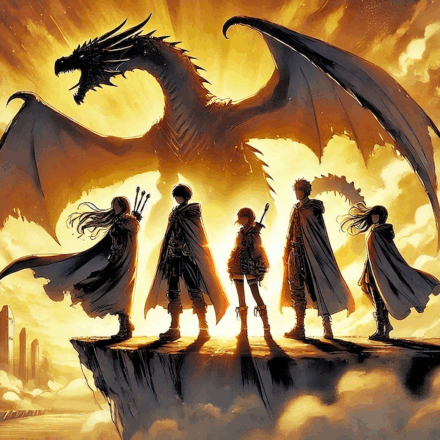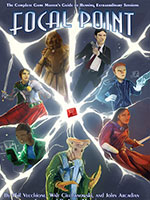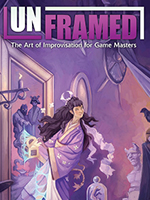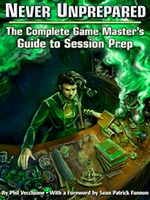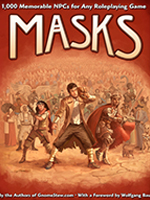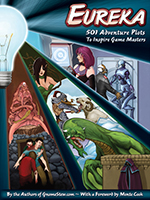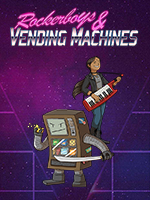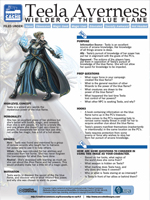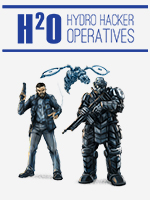
“I stand there and swing my sword.”
Even though this approach can be effective, it’s horribly boring. That’s why games in recent decades have expanded combat options to include different combat maneuvers, cool tactical choices, ongoing spell effects (positive and negative), and different approaches to “I swing my sword.” These extra bits of tactical efforts can complicate a game, but I feel that this extra layer of complexity is well worth the outcome at the end of the day.
Of course, players only have to worry about what their character can do, so they can hyperfocus in on getting the full effect of their abilities while in an encounter. This can sometimes tip the scales in favor of the PCs. I’m not saying that’s a bad thing, but there are times (especially at the higher power levels) that putting forth a challenge to your PCs can be more difficult. Yeah, you can add more HP (or the game equivalent) to the opposing forces or have them hit more often or harder, but that’s the GM’s equivalent of “I stand there and swing my sword.”
In today’s article about adventure design, I’m going to talk to you about how to make encounters in your adventures more challenging, interesting, and exciting by layering effects and combinations into the encounters to make them more interesting than a bunch of minis on a grid on the table that stand there and swing their swords at each other.
Boss Leadership
If your boss (or a lieutenant) of the adventure is present in the encounter, figure out a way they can improve the mooks’ abilities. This can be an increase in their potency, an increase in their speed/movement, the ability to attack more often, or granting them a special ability that the mooks wouldn’t normally have.
On the flip side, your boss might be able to reduce the PCs’ effectiveness in combat or cause damage to them from a distance. This will require your PCs to work harder or figure out a tactical way to get to the boss without hacking through the layers of mooks standing in the way.
Lastly, the boss might have some abilities to affect the environment in a manner that harms the PCs, forces the PCs to take a certain path, or delays their approach to where the boss awaits. Of course, if the mooks buy the boss enough time, the boss might be able to layer on plenty of effects on themself to make the final confrontation with the boss that much more difficult.
Mook Teamwork
I’ve heard it said that goblins, kobolds, and the “smaller mooks” are no danger to higher level characters, even in great numbers. I disagree. If the game supports combat maneuvers like grapple, trip, overrun, push, charge, etc., then several of the mooks can bring down that mighty fighter while the rest of them attack the downed fighter. I’ve literally made a player with a spellcaster character scream in horror when they realized that the goblins were going to grappling their character and hold the character down to prevent more casting of spells.
By using your larger groups of mooks in an intelligent manner, it can present a great challenge to your more potent characters. There are also some games that have rules for flanking or surrounding or combat advantages when surrounded by a bunch of little critters. Leverage those rules. If you’re playing a game without such rules, run some house rules by your players and work out something effective, but fair, to bring to the table.
Enemy Preparations
In The Keep on the Borderlands module, my players always hated me after they faced off against the lowly kobolds because of the traps, dastardly environments, and ambushes the kobolds put the PCs through. Even though the kobolds themselves were relatively weak, they were formidable foes because of the preparations they made in their home within the Caves of Chaos. I’ve run the adventure many times, and I’ve often found the kobolds to be just as deadly as the higher-powered troll that lived across the valley.
If the boss and/or mooks know the PCs are on their trail, they can prepare their environment, home, keep, or whatever area with quality defenses that will harm, distract, mislead, or redirect the party in a manner favorable to the enemies. Be creative and thoughtful about what materials, supplies, and time the enemy has before the PCs arrive. Allow your mooks (especially if the boss is involved or nearby) to be intelligent and effective in their defense building efforts.
Environmental Support
You can set up the environment to be more beneficial to the enemies than the PCs. Or it could hamper everyone, but the enemies are used to the environment and aren’t affected by it as badly as the PCs. There are even times when an environmental effect can heal or boost the enemies while harming the PCs at the same time.
I took an idea from one room in Undermountain (I forget which of the many different levels this room was in) in which there was a copper floor and stone tables. A flying, electrical skull would electrify the copper floor to damage anything standing on the floor. This meant the players needed to leap across the stone surfaces to avoid being zapped. Well, also in this room was a flesh golem that gained a little healing from being zapped.
The idea I had was a group of flesh golems in a room. When a creature passed or stood within ten feet of a brass support pillar, then pillar would shock them for 2d6 damage. The golems, while not horrible intelligent, had been commanded to kill anyone attempting to pass through the room, but to also not get beyond the ten foot mark from a pillar.
By adding in this environmental electricity to the battle, it made things much more difficult for the PCs. This affected their tactics, movement, damage taken, damage dealt, and all sorts of other goods in the combat. It was quite fun for all of us, and my players loved the encounter even though it was a more difficult one.
I’ve also added a lava river with a bridge over the chasm through which the lava flowed. Anyone on the bridge took a certain amount of damage as the heat from the lava roasted them. The real threat, however, came from the boss who loved casting gust of wind to knock people off the bridge and into the lava. One thing I didn’t consider during the fight was that the players knew their tactics quite well and bull-rushed several of the larger mooks (skeletal minotaurs) off the ledge and into the lava. The players’ exploits in this case shortened the combat and made things easier for them. Like any quality GM should do, I cheered them on as their tactics worked wonderfully for them.
Non-Combat Encounters
Now to address the elephant in this article. I’ve solely focused on combat encounters here. Exploration and social encounters can also be layered with elements that change the situation. I’ll briefly tackle both as this article is already getting a bit long in the tooth.
For exploration, the obvious effects are weather and terrain. I’d like to throw in vermin as being part of a challenge as well. When going through some watery or swampy areas, leeches are a huge problem. They can drain you dry of blood if you get enough of them on you, and their saliva numbs of the pain of their bite. This can lead to levels of fatigue or exhaustion (or raw damage or reduction in attributes) that must be dealt with before reaching the destination. Also, rodents getting into or bursting open food supplies is another danger that could make things more difficult for the PCs as they now face ruined foodstuffs. It’s either travel slower and hunt or starve.
For social encounters, there can be factors external to the PCs and the immediate NPCs they are dealing with. A raucous, annoying, disruptive crowd could be chanting while the PCs/NPCs are trying to have a conversation. There could also be a crowd wanting the PCs to fail (or succeed) that may sway the nature of the social interaction. Lastly, if the PCs are talking with (or negotiating with) someone of power, the person in power may have an advisor in their ear that doesn’t want the PCs to succeed. These external influences and angles can greatly change the challenge level and scope of a social encounter.



